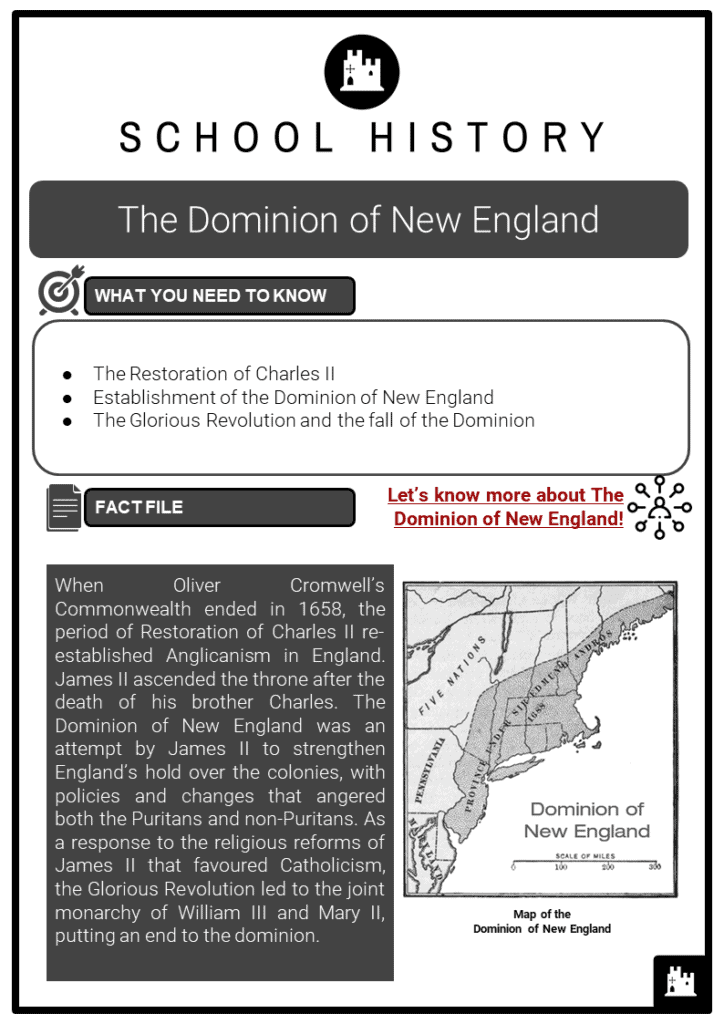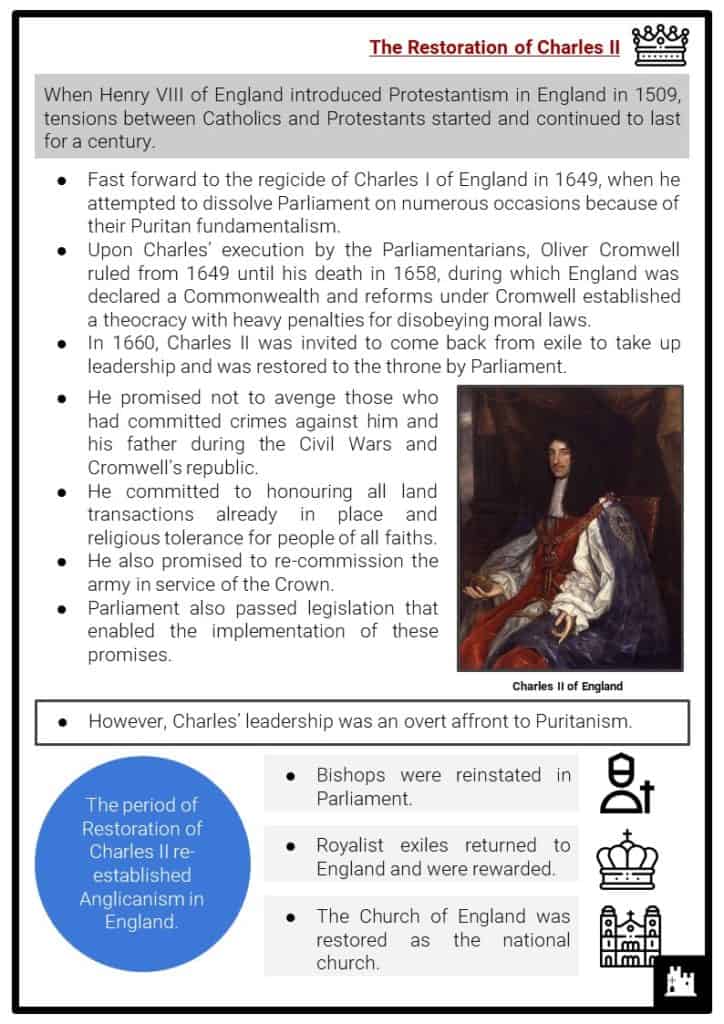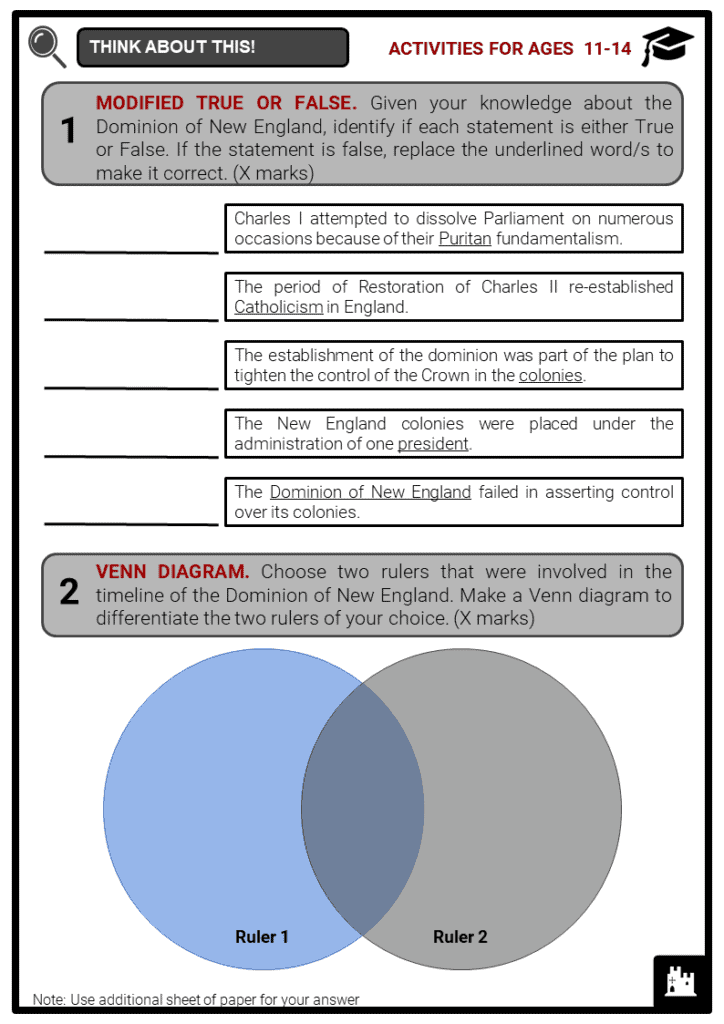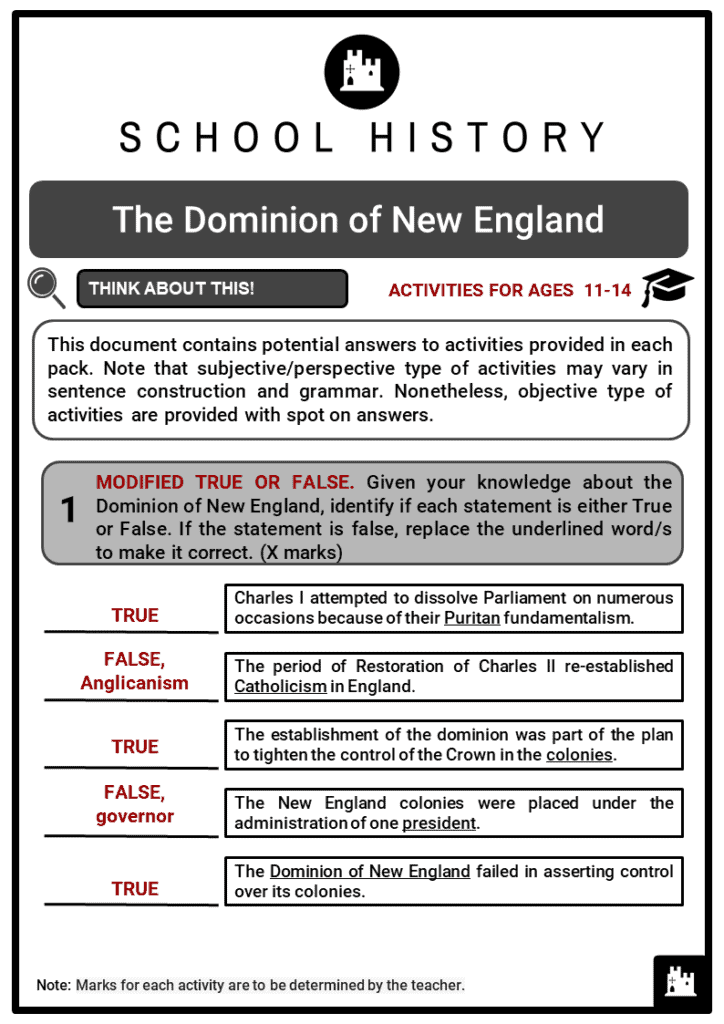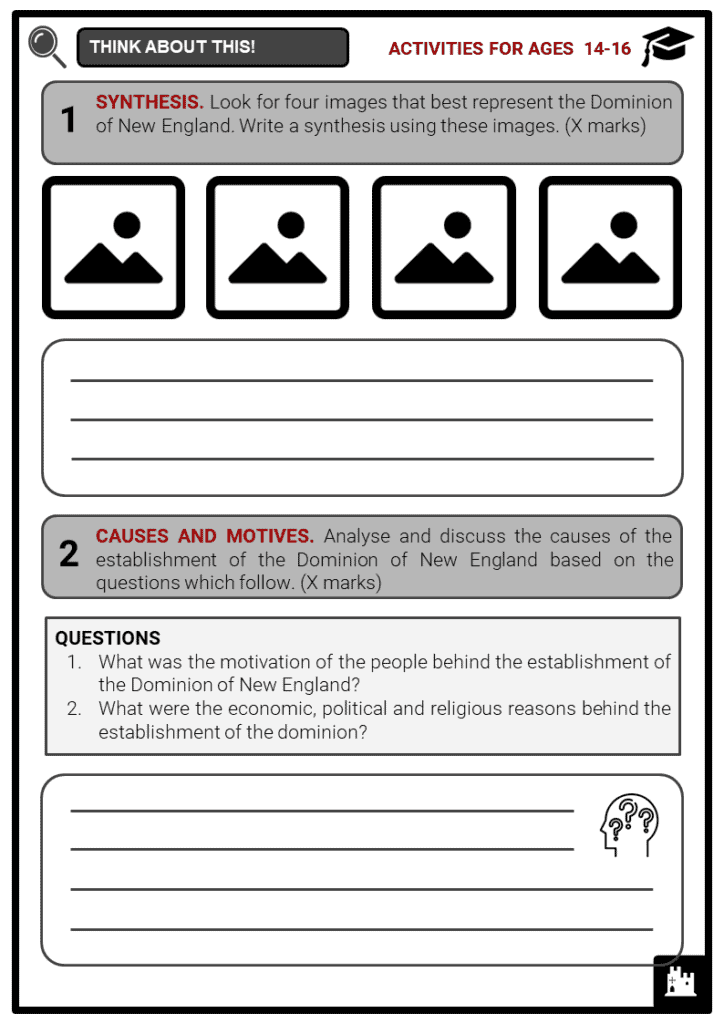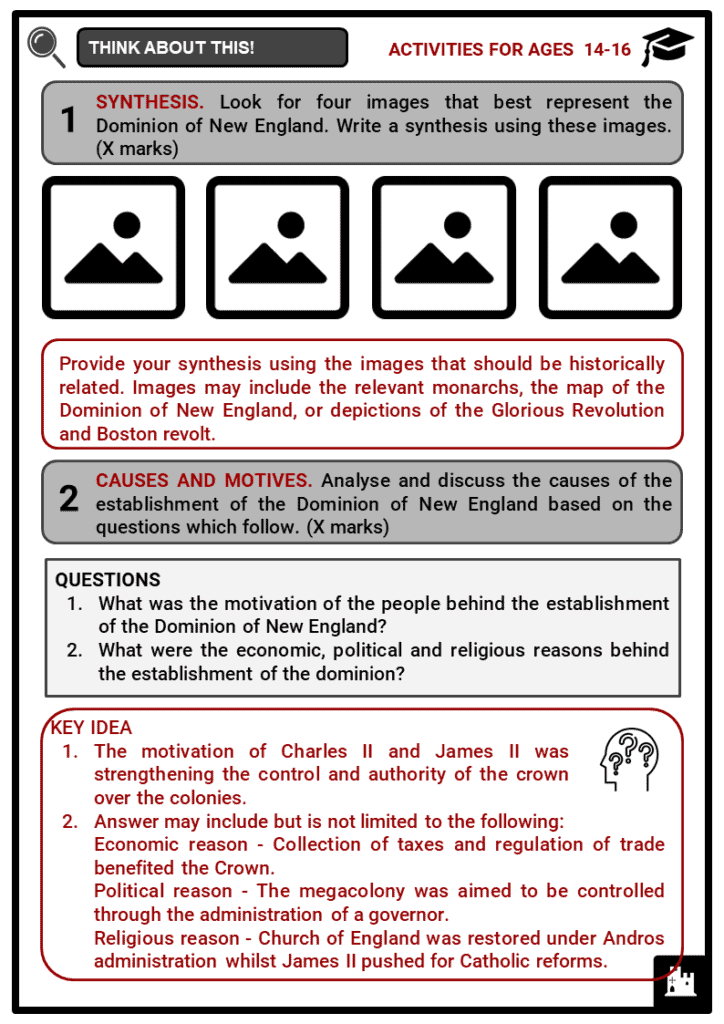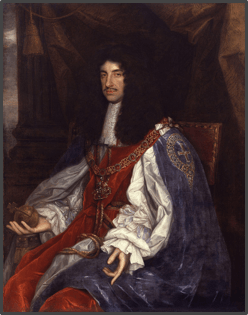Download The Dominion of New England Worksheets
Do you want to save dozens of hours in time? Get your evenings and weekends back? Be able to teach The Dominion of New England to your students?
Our worksheet bundle includes a fact file and printable worksheets and student activities. Perfect for both the classroom and homeschooling!
Table of Contents
Add a header to begin generating the table of contents
Summary
- The Restoration of Charles II
- Establishment of the Dominion of New England
- The Glorious Revolution and the fall of the Dominion
Key Facts And Information
Let’s know more about The Dominion of New England!
- When Oliver Cromwell’s Commonwealth ended in 1658, the period of Restoration of Charles II re-established Anglicanism in England. James II ascended the throne after the death of his brother Charles. The Dominion of New England was an attempt by James II to strengthen England’s hold over the colonies, with policies and changes that angered both the Puritans and non-Puritans. As a response to the religious reforms of James II that favoured Catholicism, the Glorious Revolution led to the joint monarchy of William III and Mary II, putting an end to the dominion.
The Restoration of Charles II
- When Henry VIII of England introduced Protestantism in England in 1509, tensions between Catholics and Protestants started and continued to last for a century.
- Fast forward to the regicide of Charles I of England in 1649, when he attempted to dissolve Parliament on numerous occasions because of their Puritan fundamentalism.
- Upon Charles’ execution by the Parliamentarians, Oliver Cromwell ruled from 1649 until his death in 1658, during which England was declared a Commonwealth and reforms under Cromwell established a theocracy with heavy penalties for disobeying moral laws.
- In 1660, Charles II was invited to come back from exile to take up leadership and was restored to the throne by Parliament.
- He promised not to avenge those who had committed crimes against him and his father during the Civil Wars and Cromwell’s republic.
- He committed to honouring all land transactions already in place and religious tolerance for people of all faiths.
- He also promised to re-commission the army in service of the Crown.
- Parliament also passed legislation that enabled the implementation of these promises.
- However, Charles’ leadership was an overt affront to Puritanism.
- The period of Restoration of Charles II re-established Anglicanism in England.
- Bishops were reinstated in Parliament.
- Royalist exiles returned to England and were rewarded.
- The Church of England was restored as the national church.
Establishment of the Dominion of New England
- When Charles II died without an heir in 1685, he was succeeded by his younger brother James II, who was a Catholic.
- Charles II had made attempts to restore the hold of the Imperial Crown over colonies by taking various measures to limit the independence of localities within England and its colonies.
- The New England colonies, which were mostly Puritan, operated under individual charters and enforced local regulations made by elected council.
- New England Confederation was formed by Puritan colonies including Massachusetts, Connecticut, New Haven and Plymouth and it ended when Charles II revoked the charter of Massachusetts Bay Colony in 1684.
- Continuing the efforts that Charles II started, James II established the Dominion of New England in 1686.
- It was an administrative union imposed upon the colonies of Maine, New Hampshire, Vermont, Massachusetts, Rhode Island and Connecticut. New York and New Jersey were included in the dominion’s territory in 1688.
- The establishment of the dominion was part of the plan to tighten the control of the Crown in the colonies.
- The Dominion of New England formed a megacolony.
- The seal of the dominion was the full title of the monarch as it appears on the Great Seal of the Realm.
Objectives of the Dominion of New England
- Establishment of direct control over the New England colonies
- England wanted dominance over the colonies.
- Reformation of land title practices conforming to English methods
- Land rate systems and annual tax were imposed.
- Regulation of trade and enforcement of the Navigation Acts
- Colonists were restricted to exchange goods with foreign nations.
- Strengthening of colonial defence from Native American attacks
- England planned to station more troops in the colonies for protection from further Indian conflicts.
- Reduction of the administration centres to manage the costs of the colonies
- The New England colonies were placed under the administration of one governor.
Dudley Administration
- On 14 May 1686, Joseph Dudley was made president of the Council of New England.
- The main headquarters of the dominion was in Boston.
- Dudley formally took over in Massachusetts on 25 May.
- His administration was put off when the Massachusetts magistrates opposed the elected members of the council.
- What happened under the Dudley Administration?
- Colonial military officers refused to serve.
- Judicial appointments favoured the political moderates.
- People refused to pay the few remaining taxes.
Andros Administration
- Sir Edmund Andros assumed power as the Governor in Chief of the Dominion of New England on 20 December 1686.
- His leadership was unpopular due to his disregard for existing leadership structures and dictatorial approaches.
- The composition of the council called for a representative from each colony, but because of travel inconveniences, the council’s quorum was not as diverse as it should have been.
- Andros’ leadership imposed the objectives of the dominion, which infuriated both Puritans and non-Puritans.
- What happened under the Andros Administration?
- Andros banned town hall meetings as they could culminate in a resolution to protest laws and edicts of the governor.
- He promoted the values of the Church of England, holding Anglican services in the local churches, all of which were offensive to Puritans.
- He implemented the Navigation Acts and restricted the trade of the colonies.
- His imposed taxes were seen as unjust and a violation of the Magna Carta, which made provisions for taxation by representatives of the people.
- He mainstreamed land management: a land rates system (landowners had to confirm existing land titles) and annual tax on land were introduced.
The Glorious Revolution and the fall of the Dominion
- The Glorious Revolution was a response to the actions of James II and his religious reforms, especially his attempt to reinstate Catholicism.
- The Catholic king, James II, dissolved the Test Act that required all military and civil servants to publicly accept the Anglican Church and its precepts.
- This revocation suppressed Anglicans and Puritans in England and the colonies. He openly favoured Catholic appointees as opposed to Puritans or Anglicans.
- In May 1687, he passed the Acts of Indulgence and Declaration of Indulgence that decriminalised Catholicism and further established the freedom of non-conforming religions.
- Increase Mather expressed his gratitude to James II for the declaration through a letter.
- He then led the religious leaders of Massachusetts with Cotton and planned to influence the court in London.
- Together with other Massachusetts agents, he travelled to England in 1688 to press their case against Andros’ council and were received by King James II, who promised to address the colony’s concerns.
- However, James II abdicated the throne and was replaced by his daughter and son-in-law, Mary and William of Orange, when the Glorious Revolution came about.
- The coup was successful and almost bloodless hence the name ‘Glorious Revolution.’
- The ousting and the replacement of James II were planned by the Puritans, angered by the king’s religious reforms. When the news of revolution reached the colonies, the Dominion of New England collapsed.
- The 1689 Boston revolt on 18 April had Andros, Dudley and other dominion supporters arrested.
- Leaders of the former Massachusetts Bay Colony and members of government displaced by the dominion reclaimed their power.
- Most of the colonies returned to their forms of government prior to the dominion.
- Massachusetts Bay Colony absorbed Plymouth Colony and was issued a royal charter in 1691.
- The Dominion of New England failed in asserting control over its colonies and changed the strictly Puritan independent societies to more secular royal colonies.
- The Glorious Revolution eventually gave way to the expansion of the Bill of Rights to the colonists.
- Following the failure of the dominion, England relaxed its enforcement of laws and regulations of trade in its colonies.
Image sources:
- https://upload.wikimedia.org/wikipedia/en/5/5d/Dominion-of-new-england.jpg
- https://upload.wikimedia.org/wikipedia/commons/thumb/5/51/King_Charles_II_by_John_Michael_Wright_or_studio.jpg/800px-King_Charles_II_by_John_Michael_Wright_or_studio.jpg
- https://upload.wikimedia.org/wikipedia/commons/9/99/James_II_by_Peter_Lely.jpg

